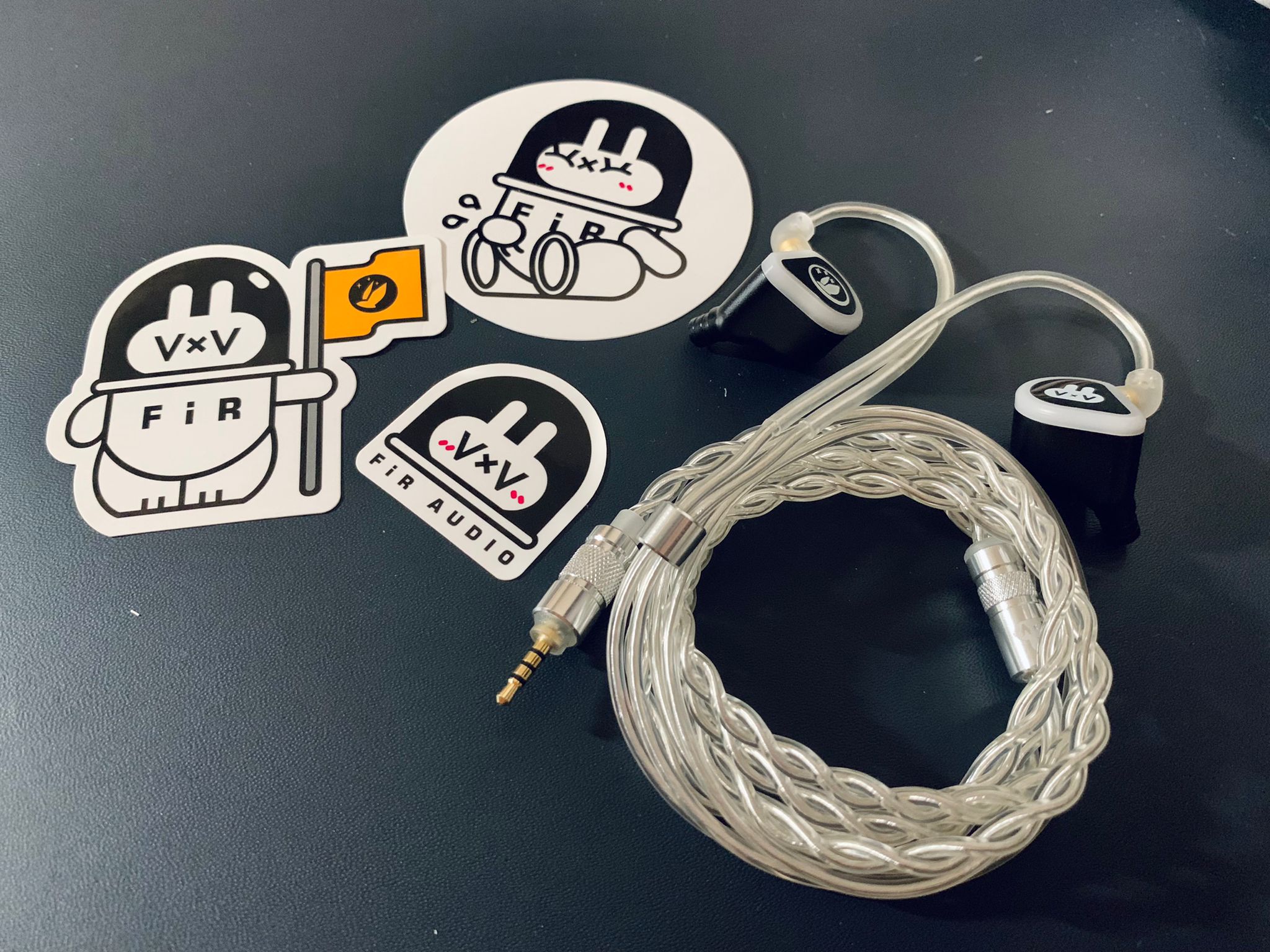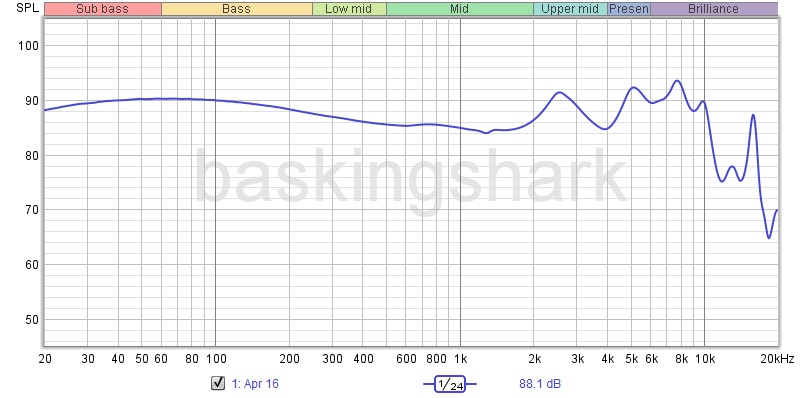INTRODUCTION
I would like to thank Kenneth from
Project Perfection for loaning this FiR Audio VxV unit. The IEM will be returned after this review. The VxV can be gotten
here!
Project Perfection is a Singaporean audio company that distributes some storied brands like Lotoo, Final Audio, DITA, Stax and FiR Audio.
FiR Audio was founded in 2018 by two brothers, Bogdan and Alex Belonozhko and their friend Daniel Lifflander. Between them, they have over 20 years of experience from working previously at 64 Audio.
FiR Audio's mascot is that of a rabbit named Firry!
EXECUTIVE SUMMARY
This FiR Audio VxV is a pretty competent 5-driver hybrid IEM that does most areas well, and has few weaknesses in the tuning. The warm-neutral signature is quite balanced to handle most music genres. In fact, I see the VxV as a jack-rabbit of all trades, and most folk should find something to like about it, perhaps other than die-hard bassheads and trebleheads.
SPECIFICATIONS
- Driver configuration: Hybrid: 1x Dynamic Driver, 2x Mid-driver Balanced Armature, 1x High-driver Balanced Armature, 1x Ultra-high Driver Balanced Armature
- Frequency response: 20 Hz – 20000Hz
- Impedance: 16 Ohms
- Sensitivity: no specs available online
- Cable: MMCX, 2.5mm TRRS balanced connector
- $999 USD
As per its namesake, the VxV contain 5 drivers for each side.
ACCESSORIES
The packaging is rather austere, coming in a small white cardboard box. BTW the Firry rabbit stuff toy is not included!!!
Other than the IEM, these are included:
- 3 pairs of silicone tips (S/M/L)
- 1 pair of double flanged silicone tips
- 1 pair of foam tips
- Cable
-
Cleaning brush
-
Leather hardcase
- 3 x Firry rabbit stickers
The cable is made of silver-plated copper. This cable is very well braided and pliant, with no microphonics. It only comes in a 2.5 mm termination, so those that use 3.5 mm or 4.4 mm sources may need an aftermarket adapter (which isn't included). There is a chin cinch to secure fit during usage.
Sadly, this cable features a semi-proprietary MMCX design, where there is a shroud over the left/right termination of the cable, and it may hence not be usable with other standard MMCX IEMs. If aftermarket MMCX cables are used, they can still pair with the VxV housing, but there will be a bit of a metal sheath that will be exposed. Nothing deal-breaking, as sound can still be generated, just that it may be a bit of an eye-sore as such.
While I'm generally not a fan of MMCX (they seem to deteriorate faster than 2-pin connectors with repeated cable changes), the MMCX quality on the VxV seems very robust. The cables snap off easily and back on without much force needed on the MMCX connectors.
The leather hard case is very elegant, with the inner layer lined by a velvety material.
Everything is pretty usable out of the box, I don't think you will need to source for aftermarket accessories for the VxV (other than the aforementioned adapters for non 2.5 mm sources). Only thing is at this pricing, the provided accessories are not exactly class-leading, but well, accessories maketh not an IEM, and I would be more interested in the sound, as we will read on below.
For the purposes of this review, the stock silicone tips and cable were used.
BUILD/COMFORT
The VxV is tear-drop shaped, and is extremely light and ergonomic, with no discomfort with prolonged usage. It is advertised to be made of hybrid 6000 aluminum and DuPont engineering plastic, which does explain the very light yet solid build.
I didn’t find any driver flex during usage; the VxV sports a unique ATOM pressure venting system, with the vents placed near the MMCX female connector region, rather than the traditional location on the shell housing. This in theory lessens listener fatigue and pressure, in addition to reducing the likelihood of driver flex.
The right earpiece showcases Firry (FiR Audio's rabbit mascot), while the left earpiece is emblazoned with FiR Audio's logo.
ISOLATION
Isolation is good (especially with the foam or double flanged tips), this set is quite usable in noisy or outdoor environments. Perhaps it can even be used as a stage monitor in view of the good isolation levels.
DRIVABILITY
I tested the VxV with:
- Khadas Tone Board -> Schiit Asgard 3 amp
- Khadas Tone Board -> Topping L30 amp
- Sony Walkman NW A-55 DAP (Walkman One WM1Z Plus v2 Mod)
- Sony Walkman NW A-55 DAP (Walkman One Neutral Mod)
- E1DA DAC/AMP dongle
- Colorfly CDA M1 DAC/AMP dongle
- IKKO Zerda ITM01 dongle
- Tempotec Sonata HD Pro dongle (BHD firmware)
- Smartphone
The VxV is pretty easy to drive from lower powered gear, but scales with amplification.
SOUND & TECHNICALITIES
The FiR Audio VxV is a warm-neutral IEM with rather good tonal balance. This makes it quite all-rounder for most music genres. Perhaps only die-hard bassheads and trebleheads may dislike this tuning as there are slight roll-offs at both extremes.
For a hybrid, the VxV is very coherent, and there aren't any awkward troughs and peaks that are audible.
Graph of the VxV via IEC711 compliant coupler. The 8 kHz area is a coupler artefact peak.
Bass on the VxV is north of neutral, but not at bona fide basshead levels. It is mid-bass focused with a slight sub-bass roll-off, though sub-bass still extends quite well. Bass quality is controlled and tight, with minimal mid-bass bleed, and the bass has good texturing and speed. Of note, the VxV kept up with the bass movements in Sting's Englishman In New York, which is my test track for bass speed and texturing; some IEMs with a slower bass may have smearing during the bass solo movements mid-track.
Midrange on the VxV is quite full-bodied at the lower mids. Upper mids are slightly boosted, but with a less than 10 dB pinna gain, this set is not shouty in the upper mids. Vocals are hence forward without being fatiguing.
Treble is moderately extended, there is good clarity and micro-details. Lower treble is boosted around the 5 kHz regions, but upper treble has a slight roll-off, hence the VxV lacks the air and sparkle that die-hard trebleheads would yearn for. There are occasions of sibilance, but by and large, treble sensitive folk should be quite at home with the tuning.
Technical aspects are pretty solid on the VxV, with good micro-details, imaging and instrument separation on tap. Soundstage is above average, it is not the tallest, but has good depth and width. Layering is no slouch and music never sounded compressed on the VxV even with tracks with complex movements.
Timbre is acceptable considering there are BAs inside. There is a slight tinge of BA timbre for acoustic instruments, but nothing really deal-breaking.
COMPARISONS
Campfire Andromeda 2020
The VxV has a deeper sub-bass extension, thicker note weight and a better soundstage than the Andromeda 2020. Timbre is slightly better on the VxV too.
My biggest bugbear with the Andromeda 2020 is that it is very fussy with sources (due to the low impedance and
rules of eights), and it also hisses with sources with a poor noise floor. The VxV on the other hand, is much more source agnostic, and not as troublesome to pair sources with. That in itself makes the VxV less finicky between these two SummitFI sets.
Sony IER-M9
The venerable M9 comes with a much better assortment of accessories.
Accessories aside, the M9 is also tuned neutralish-warm, but even so, it is slightly less bright in the lower treble than the VxV, and more laid back overall. In technical performance, the M9 is better in soundstage, layering, imaging, instrument separation.
The M9 is harder to drive though.
Earsonics Onyx
The Earsonics Onyx has a much heavier and larger shell, this can be fatiguing in terms of comfort.
The Onxy is more V-shaped with a bigger bass. The bass on the Onyx is unfortunately not as textured and bleeds into the mid-bass. The Onyx is also darker in the treble and has worse resolution, imaging, soundstage and micro-details than the FiR Audio VxV.
Mangird Xenns Up
The Xenns Up comes with a bigger spread of accessories and has a bigger sub-bass than the VxV. The Xenns Up are more basshead and also darker in the treble.
In technicalities, the Xenns Up is slightly poorer in imaging, micro-details, clarity, instrument separation than the VxV.
CONCLUSIONS
This FiR Audio VxV is a pretty competent 5-driver hybrid IEM that does most areas well, and has few weaknesses in the tuning. The warm-neutral signature is quite balanced to handle most music genres. In fact, I see the VxV as a jack-rabbit of all trades, and most folk should find something to like about it, perhaps other than die-hard bassheads and trebleheads.
My nitpicks for the VxV have to do with the packaging and semi-proprietary MMCX connectors, plus a slight BA timbre.
The VxV would be a good all-rounder and jack-rabbit of all trades TOTL model for those that are keen to sample something in SummitFI rabbit-hole. I quite enjoyed my time with the VxV and am sad to return this loaner unit. In fact, I very much look forward to what other rabbits FiR Audio can pull out of the hat (no pun intended), and watch with anticipation for their future releases!








 PW Audio no 10 mmcx also works. Cable upgrade which doesn’t break the bank (slight soundstage increase stands out).
PW Audio no 10 mmcx also works. Cable upgrade which doesn’t break the bank (slight soundstage increase stands out).









Please advise on which one to get. Meteor could save me $400 + I do like some decent bass but not too much.